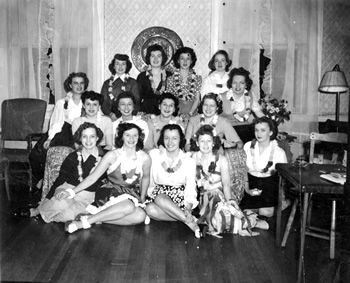
Lloyd House History
The Lloyd House
Constructed around 1796-1797, Lloyd House is one of the best examples of Alexandria’s late eighteenth-century Georgian style, and one of five buildings of the Georgian style remaining in the city. Lloyd House is particularly important to the streetscape of Washington Street, part of the George Washington Memorial Parkway.
Today, the Lloyd House is home to the administrative offices of the Office of Historic Alexandria and can be rented for private events.
Further Reading
- A History of Lloyd House, Part I The Early Years: 1796 – 1832, Timothy Denneé.
Historic Alexandria Quarterly, Fall 2003/Winter 2004. - A History of Lloyd House, Part II History of the Structure: 1833 - 1918; Lloyd House Enters the 20th Century: 1918 - 1956. Timothy Denneé.
Historic Alexandria Quarterly, Spring/Summer 2004.
Early History

It is assumed that the Lloyd house was built by John Wise who owned the land and also built and operated the City Hotel (Gadsby’s Tavern) around the same time. There are many similarities between the two buildings.
The building is also historically significant due to the number of prominent people who lived there. Occupied initially by John Wise, it was then leased to Charles Lee, younger brother of Henry “Light-Horse Harry” Lee. Charles Lee served in the presidential administrations of George Washington and John Adams as attorney General and was appointed to a position as a federal judge during the last hours of Adams’ administration. Lee returned to private law practice, serving as council for the plaintiffs in the landmark Supreme Court case, Marbury vs Madison. He later participated with the defense in the impeachment trial of Justice Samuel Chase and treason trial of Aaron Burr.
Jacob Hoffman purchased the house and its nearly half acre lot in 1810 and soon became engaged in an extremely profitable enterprise – the refining of sugar. The production of sugar was profitable for a very brief time, and by 1825 the house and its garden were sold to Elizabeth Hooe.
In 1826, Hooe invited Benjamin Hallowell, a Quaker educator and tutor of Robert E. Lee, to move his school to the site. The school was quickly a success in terms of the numbers of students who were educated there, but Hallowell was deeply in debt. He later converted the sugar refinery and tobacco warehouse on the adjacent property to a residence and dormitory for his boarding school, and Lloyd House was sold again. Hallowell continued his school until 1842 in another location, ultimately employing a total of 29 teachers during his career in Alexandria. Hallowell educated hundreds of children and presented scientific lectures to their parents, often at The Lyceum, which he founded in 1839.
John Lloyd bought the house at auction and took possession of his new home in December 1833. Lloyd was a successful dry goods merchant and soon began investing extensively in real estate. His wife, Anne Harriotte Lee, was a first cousin of Robert E. Lee and frequently entertained Lee in the house. The Lloyd family owned the home until 1918.
Early 20th Century

The next occupants were William Albert Smoot, Jr. and his descendants. Smoot, a lumber dealer, served as Mayor of the City under the first city manager form of government. He also served a s a member of the Virginia House of Delegates. The Smoot family owned Lloyd House until 1942.
World War II

During World War II, 52 members of the Navy Women’s Reserve (WAVES) occupied the house while they were employed at the U. S. Naval Torpedo Station on Union Street. After the war it continued to house female civilians; it was reportedly popular with military and government personnel and stewardesses from National Airport-based Capital Airlines.
Lloyd House Restoration
By 1956 the house was slated for demolition until Wyoming geologist Robert Valentine New read about the possible loss and purchased the property. The Historic Alexandria Foundation secured the money to buy out the demolition contract. New began a renovation in 1960 and used it for his offices. Later he proposed the Lloyd House Center, a nine-story office building.
By 1966 the City of Alexandria had determined that it was necessary to try to save the building and purchase it from Robert New. The Alexandria Historical Restoration and Preservation Commission, founded in 1962, took on the project of raising funds for the purchase of the building and for its subsequent rehabilitation. Funding for the purchase and restoration came from various sources, including the Hoge Foundation, federal, state and local governments, and private donations.
The restored Lloyd House was then leased to the Alexandria Library for historical collections. In 1999 the Local History/Special Collections branch moved from the Lloyd House to the Barrett Library across the street.
The Lloyd House was further restored in 2002-2007. Funding for this later restoration was provided by the City of Alexandria and the Save America’s Treasures Historic Preservation Fund. The Lloyd House is now the administrative headquarters of the Office of Historic Alexandria.